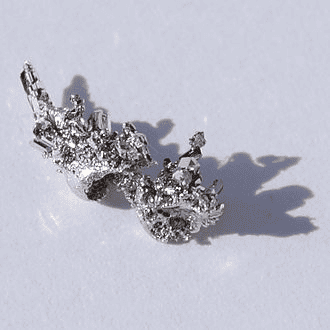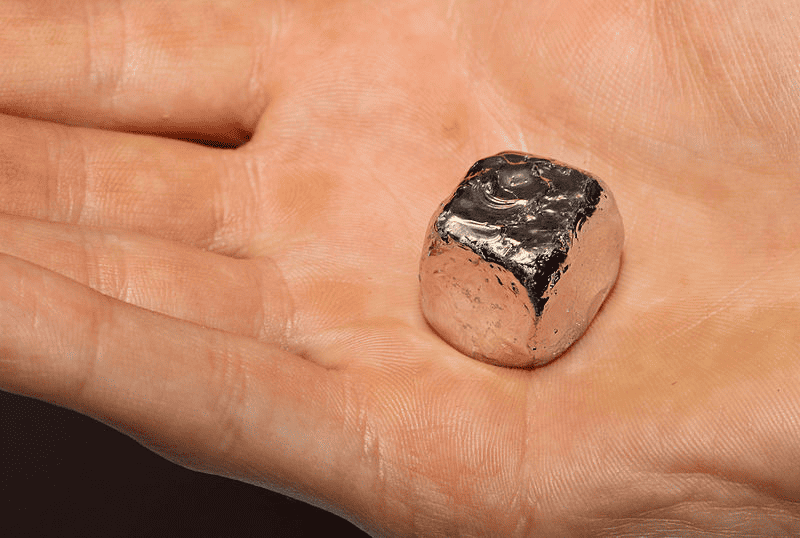According to chemists, there are 94 metals on the periodic table. Most are abundant, and miners can easily find them in large quantities. However, there are also rare metals that are difficult to find, and extracting them can cost a lot of money.
These rare metals usually attract more attention from people. After all, it is quite astonishing to find these rare metals, and finding them can be financially rewarding. So, if you are interested in knowing which of the metals are rare, you better read on. We have made a list of the 8 rarest metals in the world!
8. Gold
Phase: Solid
Boiling point: 2970 °C (5378 °F)
Melting point: 1064.18 °C (1947.52 °F)
Density: 19.3 g/cm3

While gold isn’t the rarest metal, it is difficult to find and extract in huge quantities, even with modern technology. Aside from that, the extensive use of gold in various industries increases its demand, further depleting the supply of gold.
When gold was first discovered, it instantly received wide recognition for its numerous applications. Processing gold is fairly straightforward. Gold does not rust or tarnish that easily compared to copper and silver. The gold’s appearance looks beautiful, and thus, people use it in jewelry. Although gold is widely used today, its value and demand remain high.
Did you know?
Gold is highly malleable and ductile. With the right tools, you can stretch one ounce of gold into a thread that extends up to 5 miles long. The rarest type of gold is called “Welsh Gold.” Gold mined from riverbeds is called “Alluvial Gold.”
7. Platinum
Phase: Solid
Boiling point: 3825 °C (6917 °F)
Melting point: 1768.3 °C (3214.9 °F)
Density: 21.45 g/cm3

Platinum is not just rare, but it is one of the most expensive precious metals today. Miners usually find platinum in an impure state. It is generally mixed with gold, copper, iron, and nickel.
You would be surprised to know there is more platinum on the moon and meteorites in other space. Platinum has a 95% purity, making it one of the purest metals.
Because of the extreme rarity of platinum, people only use it as a substitute if the primary raw material is unavailable. Platinum is commonly used in jewelry, electronics, dentistry, anti-pollution devices, petroleum refineries, and medicines.
Platinum has a very high melting point. It does not oxidize quickly and is stable. Because of its chemical properties, it serves as a great electric conductor.
Did you know?
People didn’t immediately recognize the value of platinum when it was first discovered. The name platinum came from the Spanish word “Platina,” which means “little silver.” Initially, miners considered platinum useless, so miners often discard platinum when separated from other metals.
6. Osmium
Phase: Solid
Boiling point: 5012 °C, 9054 °F
Melting point: 3033 °C (5491 °F)
Density: 20 g/cm3

Osmium naturally occurs in nature uncombined or with another metal such as iridium. Most of the osmium found in the market is usually gathered from the waste product of refining nickels.
When osmium was first discovered, people immediately learned how toxic it was. Its raw form, the “osmium” sponge, can cause damage to the eye, skin, and lungs. Thankfully, in 2014, Swiss scientists found an effective way to crystalize osmium and remove its toxicity.
Did you know?
Osmium is the last precious metal listed on the periodic table and is extremely rare. Osmium is so rare that it is 1,500 times rarer than gold. To give you an idea, you need about 10,000 tons of platinum ore to yield 30 grams of osmium.
5. Iridium
Phase: Solid
Boiling point: 4130 °C (7466 °F)
Melting point: 2446 °C (4435 °F)
Density: 22.56 g/cm3

Have you heard about iridium? If not, that’s okay. That’s understandable since iridium is rare and difficult to find. Usually, miners collect iridium from refining nickel. They occur in very little quantity.
What’s fascinating is that experts have found a thin layer of iridium in the crust of the Earth. Some theorize that the iridium layer formed millions of years ago when an asteroid hit the planet. This theory might be true, especially considering that asteroids have a higher level of iridium than the Earth’s.
Did you know?
Due to the colorful appearance of iridium salts, discoverers of this metal named it iridium, derived from the Greek word for rainbows. However, refined iridium has a silvery color.
4. Palladium
Phase: Solid
Boiling point: 2963 °C (5365 °F)
Melting point: 554.9 °C (2830.82 °F)
Density: 12.02 g/cm3

Palladium is an elegant silvery-white metal prized for its ability to withstand high temperatures and resist corrosion. The physical and chemical properties of palladium make it indispensable in applications from catalytic converters in cars to electronics and dentistry.
Palladium is so rare that it is 15 times rarer than platinum, which is already scarce. Major palladium mining areas are Russia, South Africa, Canada, and the United States. Because palladium is rare, it is often reused and recycled.
Interestingly, palladium has the lowest melting point in the platinum group metals (PGMs). Not only that, but it is also the least dense.
Did you know?
According to Homer’s Iliad, palladium refers to an object that provides divine protection. However, the discoverer of palladium, Wollaston, explained that he got the name from the asteroid Pallas.
3. Rhenium
Phase: Solid
Boiling point: 5630 °C (10,170 °F)
Melting point: 3186 °C (5767 °F)
Density: 21.02 g/cm3

Rhenium is one of the rarest metals on Earth and one of its most intriguing elements. Rhenium is a silvery-white metal with an extremely high melting point and dense structure, making it valuable in jet engines and other high-temperature applications.
Furthermore, Rhenium is an essential catalyst in chemical processing to speed up reactions while reducing energy requirements to produce certain chemicals.
But why is rhenium so rare? This elusive metal is only found in trace amounts in Earth’s crust. According to some estimates, rhenium occurs on Earth’s continental crust for less than one part per billion.
Rhenium is one of the world’s rarest and costliest metals to extract from Earth’s crust. However, scientists and engineers continue to find innovative uses for it.
Did you know?
Rhenium is derived from the Latin word “Rhine,” which is Rhenus. The scientific community generally considers Noddack, Tacke, and Berg as the discoverers of this rare metal.
2. Ruthenium
Phase: Solid
Boiling point: 4150 °C (7502 °F)
Melting point: 2334 °C (4233 °F)
Density: 12.45 g/cm3

Ruthenium sounds like a name from a fantasy novel or movie, but don’t let its name fool you. It is one of the rarest metals in the world, accounting for about 10−7% of the Earth’s crust.
One reason ruthenium is so rare is its affinity with platinum and palladium, both of which require significant investments to mine and are hard and costly to extract. Furthermore, ruthenium’s chemical properties make it hard for miners to separate ruthenium from other metals.
Ruthenium is an exceptional material because of its remarkable strength and corrosion resistance. For this reason, ruthenium is suitable for use in various industrial applications like electronics and catalytic converters.
Its powerful anticancer effects make ruthenium an excellent addition to cancer drug therapies. In trials, it has shown promising results in inhibiting tumor cell growth.
Did you know?
Ruthenium is derived from Russia’s Latin name, Ruthenia, which refers to the Ural Mountains of Russia.
1. Rhodium
Phase: Solid
Boiling point: 3695 °C, 6683 °F
Melting point: 1964 °C, 3567 °F
Density: 12.41 g/cm3

Rhodium is the rarest metal in the world. It occurs one part per 200 million in the Earth’s crust. Because of the extreme rarity of rhodium, it is super expensive and even more valuable than gold. Only diamonds can beat rhodium in terms of trading price.
Rhodium’s rarity stems from its unique physical and chemical properties. Rhodium is an inert metal that doesn’t readily combine with other elements to form minerals or ores. This chemical property makes its extraction and refinement difficult, reducing global supplies.
Rhodium may be scarce, yet its uses remain diverse. Due to its resistance to corrosion and ability to reflect light, rhodium is ideal for jewelry applications, often used to plate white gold and silver for increased durability and shine.
Whenever available, car manufacturers use rhodium as part of catalytic converters to reduce harmful emissions from their engines.
Did you know?
Rhodium is known to have no biological role. On the contrary, some experts consider it as carcinogenic. Because of its properties, Rhodium is commonly used as an electrical contact material.
